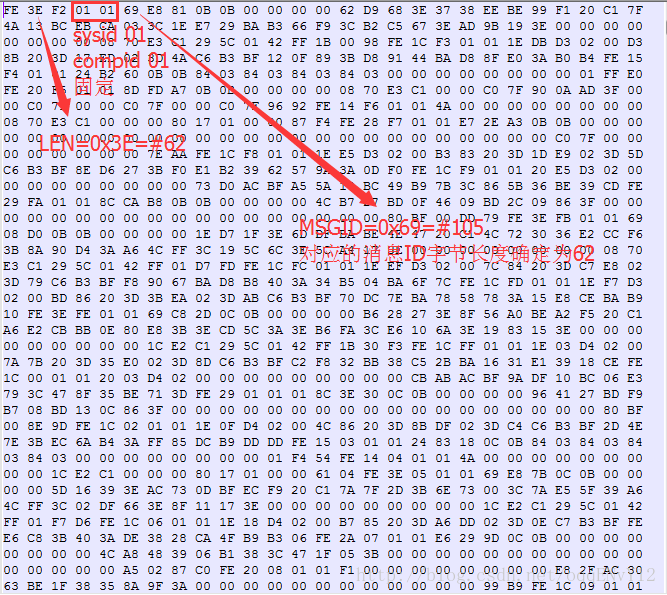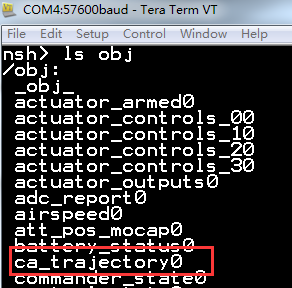Pixhawk原生固件PX4之自定义MAVLink消息
欢迎交流~ 个人 Gitter 交流平台,点击直达:
本着想在PX4基础上加点什么东西的我又开始折腾了,先尝试用串口加传感器通过QGC查看,要是能在原固件上加点内容就棒哉了。先立Flag
自定义uORB消息
ca_trajectory.msg
uint64 time_start_usec
uint64 time_stop_usec
uint32 coefficients
uint16 seq_id
#TOPICS ca_trajectory自定义MAVLink消息
custom_messages.xml
<mavlink>
<include>common.xmlinclude>
<enums>
enums>
<messages>
<message id="166" name="CA_TRAJECTORY">
<description>This message encodes all of the raw rudder sensor data from the USV.description>
<field type="uint64_t" name="timestamp">Timestamp in milliseconds since system bootfield>
<field type="uint64_t" name="time_start_usec">start time, unit usec.field>
<field type="uint64_t" name="time_stop_usec">stop time, unit usec.field>
<field type="uint32_t" name="coefficients">as it says.field>
<field type="uint16_t" name="seq_id">can not cheat any more.field>
message>
messages>
mavlink>使用python -m mavgenerate打开mavlink消息生成器导入上面的xml文件,生成如下文件:

将生成的custom_messages文件夹拖到Firmware/mavlink/include/mavlink/v1.0目录下
发送自定义MAVLink消息
添加mavlink的头文件和uorb消息到mavlink_messages.cpp
#include 在mavlink_messages.cpp中创建一个新的类
class MavlinkStreamCaTrajectory : public MavlinkStream
{
public:
const char *get_name() const
{
return MavlinkStreamCaTrajectory::get_name_static();
}
static const char *get_name_static()
{
return "CA_TRAJECTORY";
}
static uint8_t get_id_static()
{
return MAVLINK_MSG_ID_CA_TRAJECTORY;
}
uint8_t get_id()
{
return get_id_static();
}
static MavlinkStream *new_instance(Mavlink *mavlink)
{
return new MavlinkStreamCaTrajectory(mavlink);
}
unsigned get_size()
{
return MAVLINK_MSG_ID_CA_TRAJECTORY_LEN + MAVLINK_NUM_NON_PAYLOAD_BYTES;
}
private:
MavlinkOrbSubscription *_sub;
uint64_t _ca_traj_time;
/* do not allow top copying this class */
MavlinkStreamCaTrajectory(MavlinkStreamCaTrajectory &);
MavlinkStreamCaTrajectory& operator = (const MavlinkStreamCaTrajectory &);
protected:
explicit MavlinkStreamCaTrajectory(Mavlink *mavlink) : MavlinkStream(mavlink),
_sub(_mavlink->add_orb_subscription(ORB_ID(ca_trajectory))), // make sure you enter the name of your uorb topic here
_ca_traj_time(0)
{}
void send(const hrt_abstime t)
{
struct ca_trajectory_s _ca_trajectory; //make sure ca_trajectory_s is the definition of your uorb topic
if (_sub->update(&_ca_traj_time, &_ca_trajectory)) {
mavlink_ca_trajectory_t msg;//make sure mavlink_ca_trajectory_t is the definition of your custom mavlink message
msg.timestamp = _ca_trajectory.timestamp;
msg.time_start_usec = _ca_trajectory.time_start_usec;
msg.time_stop_usec = _ca_trajectory.time_stop_usec;
msg.coefficients =_ca_trajectory.coefficients;
msg.seq_id = _ca_trajectory.seq_id;
mavlink_msg_ca_trajectory_send_struct(_mavlink->get_channel(), &msg);
}
}
};附加流类streams_list的到mavlink_messages.cpp底部
StreamListItem *streams_list[] = {
...
new StreamListItem(&MavlinkStreamCaTrajectory::new_instance, &MavlinkStreamCaTrajectory::get_name_static, &MavlinkStreamCaTrajectory::get_id_static),
nullptr
};最后在mavlink_main.cpp加入自定义的消息以及期望的更新频率
configure_stream("CA_TRAJECTORY", 100.0f);接收自定义MAVLink消息
在mavlink_receiver.h中增加一个用来处理接收信息得函数
#include 在 mavlink_receiver.h中增加一个处理类MavlinkReceiver 中的输入mavlink消息的函数
void handle_message_ca_trajectory_msg(mavlink_message_t *msg);在 mavlink_receiver.h中加入一个类MavlinkReceiver中的uORB消息发布者
orb_advert_t _ca_traj_msg_pub;在mavlink_receiver.cpp中实现handle_message_ca_trajectory_msg功能
void
MavlinkReceiver::handle_message_ca_trajectory_msg(mavlink_message_t *msg)
{
mavlink_ca_trajectory_t traj;
mavlink_msg_ca_trajectory_decode(msg, &traj);
struct ca_trajectory_s f;
memset(&f, 0, sizeof(f));
f.timestamp = hrt_absolute_time();
f.seq_id = traj.seq_id;
f.time_start_usec = traj.time_start_usec;
f.time_stop_usec = traj.time_stop_usec;
f.coefficients = traj.coefficients;
if (_ca_traj_msg_pub == nullptr) {
_ca_traj_msg_pub = orb_advertise(ORB_ID(ca_trajectory), &f);
} else {
orb_publish(ORB_ID(ca_trajectory), _ca_traj_msg_pub, &f);
}
}最后确定函数在MavlinkReceiver::handle_message()中被调用
# 在mavlink_receiver.cpp文件中添加
MavlinkReceiver::handle_message(mavlink_message_t *msg)
{
switch (msg->msgid) {
...
case MAVLINK_MSG_ID_CA_TRAJECTORY:
handle_message_ca_trajectory_msg(msg);
break;
...
}消息查看
将SD卡插入飞控连接电脑,然后会发现串口调试助手不停地吐MAVLink消息,如下所示(选择Hex方式接收,否则看到的都是乱码):

可以很容易的解析出每一帧MAVLink消息的内容,依次按照下图所示的顺序

| 字节 | 内容 | 数值 |
|---|---|---|
| 0 | 起始标志位 | 0~255 |
| 1 | 载荷长度 | 0~255 |
| 2 | 包序号 | 0~255 |
| 3 | SYSID | 1~255 |
| 4 | COMPID | 0~255 |
| 5 | MSGID | 0~255 |
| 6~(n+6) | 载荷 | (0~255)字节 |
| (n+7)~(n+8) | 冗余校验 | XXX |
可以看到,并不是每一个MAVLink消息都是一直启动的,只有心跳包是时刻不断的发送消息的(1Hz),其他的自启MAVLink消息规律暂时找不到,至少现在在串口读到的数据中还是找不到我定义的MSGID #166 = 0x6A。
要确认自定义的MAVLink真的存在,目前可以通过NSH查看
ls obj
与预想的直接可以在QGC地面站查看还有一定的差距。
大家有好办法的欢迎交流指导。
参考
1. PX4中文维基之定义MAVlink消息
2. 自定义uORB消息
3. 创建MAVLink消息
4. 生成MAVLink文件
By Fantasy